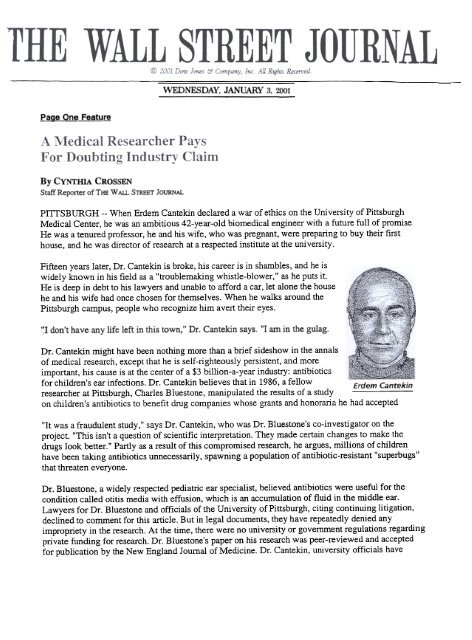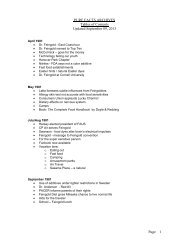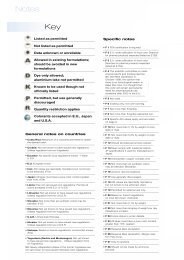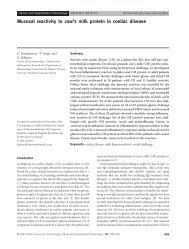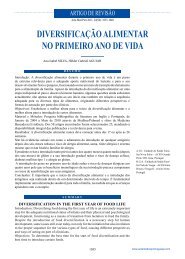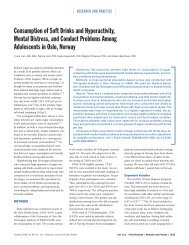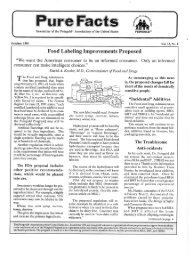PITTSBURGH --When Erdem Cantekin declared a war of ethics on ...
PITTSBURGH --When Erdem Cantekin declared a war of ethics on ...
PITTSBURGH --When Erdem Cantekin declared a war of ethics on ...
Create successful ePaper yourself
Turn your PDF publications into a flip-book with our unique Google optimized e-Paper software.
WEDNESDAY, JANUARY 3, 2001<br />
Page One Feature<br />
By CYNTHIA CROSSEN<br />
S taff Reporter<br />
<str<strong>on</strong>g>of</str<strong>on</strong>g> THE W ALL STREET JOURNAL<br />
<str<strong>on</strong>g>PITTSBURGH</str<strong>on</strong>g> --<str<strong>on</strong>g>When</str<strong>on</strong>g> <str<strong>on</strong>g>Erdem</str<strong>on</strong>g> <str<strong>on</strong>g>Cantekin</str<strong>on</strong>g> <str<strong>on</strong>g>declared</str<strong>on</strong>g> a <str<strong>on</strong>g>war</str<strong>on</strong>g> <str<strong>on</strong>g>of</str<strong>on</strong>g> <str<strong>on</strong>g>ethics</str<strong>on</strong>g> <strong>on</strong> the University <str<strong>on</strong>g>of</str<strong>on</strong>g> Pittsburgh<br />
Medical Center, he was an ambitious 42-year-old biomedical engineer with a future full <str<strong>on</strong>g>of</str<strong>on</strong>g> promise<br />
He was a tenured pr<str<strong>on</strong>g>of</str<strong>on</strong>g>essor, he and his wife, who was pregnant, were preparing to buy their first<br />
house, and he was director <str<strong>on</strong>g>of</str<strong>on</strong>g> research at a respected institute at the university.<br />
Fifteen years later, Dr. <str<strong>on</strong>g>Cantekin</str<strong>on</strong>g> is broke, his career is in shambles, and he is<br />
widely known in his field as a "troublemaking whistle-blower," as he puts it.<br />
He is deep in debt to his lawyers and unable to afford a car , let al<strong>on</strong>e the house<br />
he and his wife had <strong>on</strong>ce chosen for themselves. <str<strong>on</strong>g>When</str<strong>on</strong>g> he walks around the<br />
Pittsburgh campus, people who recognize him avert their eyes.<br />
':1 d<strong>on</strong>'t have any life left in this town," Dr. <str<strong>on</strong>g>Cantekin</str<strong>on</strong>g> says. "I am in the gulag.<br />
Dr. <str<strong>on</strong>g>Cantekin</str<strong>on</strong>g> might have been nothing more than a brief sideshow in the annals<br />
<str<strong>on</strong>g>of</str<strong>on</strong>g> medical research, except that he is self-righteously persistent, and more<br />
important, his cause is at the center <str<strong>on</strong>g>of</str<strong>on</strong>g> a $3 billi<strong>on</strong>-a-year industry: antibiotics<br />
for children's ear infecti<strong>on</strong>s. Dr. <str<strong>on</strong>g>Cantekin</str<strong>on</strong>g> believes that in 1986, a fellow<br />
<str<strong>on</strong>g>Erdem</str<strong>on</strong>g> <str<strong>on</strong>g>Cantekin</str<strong>on</strong>g><br />
researcher at Pittsburgh, Charles Bluest<strong>on</strong>e, manipulated the results <str<strong>on</strong>g>of</str<strong>on</strong>g> a study<br />
<strong>on</strong> children's antibiotics to benefit drug companies whose grants and h<strong>on</strong>oraria he had accepted<br />
"It was a fraudulent study," says Dr. <str<strong>on</strong>g>Cantekin</str<strong>on</strong>g>, who was Dr. Bluest<strong>on</strong>e's co-investigator <strong>on</strong> the<br />
project. "This isn't a questi<strong>on</strong> <str<strong>on</strong>g>of</str<strong>on</strong>g> scientific interpretati<strong>on</strong>. They made certain changes to make the<br />
drugs look better." Partly as a result <str<strong>on</strong>g>of</str<strong>on</strong>g> this compromised research, he argues, milli<strong>on</strong>s <str<strong>on</strong>g>of</str<strong>on</strong>g> children<br />
have been taking antibiotics unnecessarily, spawning a populati<strong>on</strong> <str<strong>on</strong>g>of</str<strong>on</strong>g> antibiotic-resistant "superbugs"<br />
that threaten every<strong>on</strong>e.<br />
Dr. Bluest<strong>on</strong>e, a widely respected pediatric ear specialist, believed antibiotics were useful for the<br />
c<strong>on</strong>diti<strong>on</strong> called otitis media with effusi<strong>on</strong>, which is an accumulati<strong>on</strong> <str<strong>on</strong>g>of</str<strong>on</strong>g> fluid in the middle ear.<br />
Lawyers for Dr. Bluest<strong>on</strong>e and <str<strong>on</strong>g>of</str<strong>on</strong>g>ficials <str<strong>on</strong>g>of</str<strong>on</strong>g> the University <str<strong>on</strong>g>of</str<strong>on</strong>g>Pittsburgh, citing c<strong>on</strong>tinuing litigati<strong>on</strong>,<br />
declined to comment for this article. But in legal documents, they have repeatedly denied any<br />
impropriety in the research. At the time, there were no university or government regulati<strong>on</strong>s regarding<br />
private funding for research. Dr. Bluest<strong>on</strong>e's paper <strong>on</strong> his research was peer-reviewed and accepted<br />
for publicati<strong>on</strong> by the New England Journal <str<strong>on</strong>g>of</str<strong>on</strong>g> Medicine. Dr. <str<strong>on</strong>g>Cantekin</str<strong>on</strong>g>, university <str<strong>on</strong>g>of</str<strong>on</strong>g>ficials have
Page 2 <str<strong>on</strong>g>of</str<strong>on</strong>g> 7<br />
maintained, was making his allegati<strong>on</strong>s out <str<strong>on</strong>g>of</str<strong>on</strong>g> "malice" because his point <str<strong>on</strong>g>of</str<strong>on</strong>g> view <strong>on</strong> the study had<br />
been ovelTidden.<br />
In the years since the two doctors split over their research, Dr. <str<strong>on</strong>g>Cantekin</str<strong>on</strong>g>'s allegati<strong>on</strong>s against Dr.<br />
Bluest<strong>on</strong>e have been weighed by three University <str<strong>on</strong>g>of</str<strong>on</strong>g> Pittsburgh committees, three panels <str<strong>on</strong>g>of</str<strong>on</strong>g> the<br />
Nati<strong>on</strong>al Institutes <str<strong>on</strong>g>of</str<strong>on</strong>g> Health, a c<strong>on</strong>gressi<strong>on</strong>al subcommittee, a federal district court and the U.S.<br />
Court <str<strong>on</strong>g>of</str<strong>on</strong>g> Appeals. The government, the university and Dr. <str<strong>on</strong>g>Cantekin</str<strong>on</strong>g> have spent thousands <str<strong>on</strong>g>of</str<strong>on</strong>g> hours<br />
and milli<strong>on</strong>s <str<strong>on</strong>g>of</str<strong>on</strong>g> dollars trying to sort out what happened in that Pittsburgh medical laboratory in the<br />
mid-1980s. And it isn't over yet: Dr. <str<strong>on</strong>g>Cantekin</str<strong>on</strong>g> has brought a whistle-blower lawsuit against his<br />
adversaries, and a trial looms.<br />
Deadly C<strong>on</strong>sequences<br />
But as the dispute has moved slowly through these tribunals, medical science has gradually come to<br />
its own c<strong>on</strong>clusi<strong>on</strong>s about antibiotics and ear infecti<strong>on</strong>s --and they are in line with Dr. <str<strong>on</strong>g>Cantekin</str<strong>on</strong>g>'s.<br />
Although more antibiotics are prescribed today for children's ear infecti<strong>on</strong>s --and for l<strong>on</strong>ger periods<br />
<str<strong>on</strong>g>of</str<strong>on</strong>g> time --in the U.S. than anywhere in the world, several recent, independently financed studies have<br />
found that for the vast majority <str<strong>on</strong>g>of</str<strong>on</strong>g> ear infecti<strong>on</strong>s, antibiotics are little more effective than no treatment<br />
at all. Worse, physicians are now seeing in their own practices the potentially deadly c<strong>on</strong>sequences <str<strong>on</strong>g>of</str<strong>on</strong>g><br />
too many children taking too many antibiotics --drug-resistant strains <str<strong>on</strong>g>of</str<strong>on</strong>g> bacteria. In the past few<br />
years, some pediatricians have begun to prescribe shorter courses <str<strong>on</strong>g>of</str<strong>on</strong>g> antibiotics, or even to take a<br />
different tack entirely: so-called watchful waiting. If the infecti<strong>on</strong> doesn't clear up in a few days, then<br />
antibiotics are used.<br />
This approach would have been anathema to the pediatricians <str<strong>on</strong>g>of</str<strong>on</strong>g> the 1960s and'70s, for whom<br />
antibiotics were a miracle drug. In the 1940s and '50s, it was unusual for a child to see a doctor for a<br />
simple earache --there was little that could be d<strong>on</strong>e for them, and they usually cleared up anyway.<br />
But the c<strong>on</strong>sequences <str<strong>on</strong>g>of</str<strong>on</strong>g> untreated ear infecti<strong>on</strong>s were well-known and occasi<strong>on</strong>ally dire. Some<br />
children suffered mastoiditis, meningitis, hearing loss and even death. Doctors and researchers<br />
suspected that antibiotics could help prevent some <str<strong>on</strong>g>of</str<strong>on</strong>g> these catastrophes, but there was no scientific<br />
pro<str<strong>on</strong>g>of</str<strong>on</strong>g>.<br />
That was the issue Dr. <str<strong>on</strong>g>Cantekin</str<strong>on</strong>g> and his then-mentor, Dr. Bluest<strong>on</strong>e, decided to tackle in the early<br />
1980s. The two men had met in Bost<strong>on</strong> several years earlier. Dr. Bluest<strong>on</strong>e, a graduate <str<strong>on</strong>g>of</str<strong>on</strong>g> the<br />
University <str<strong>on</strong>g>of</str<strong>on</strong>g> Pittsburgh and its medical school, was fast making a name for himself in pediatric<br />
otolaryngology. He has written more than 300 articles <strong>on</strong> the subject, as well as serving <strong>on</strong><br />
government advisory boards. Dr. <str<strong>on</strong>g>Cantekin</str<strong>on</strong>g>, who was born and raised in Turkey, where his father was<br />
a middle-class public servant, had come to the U.S. to study at the Camegie Institute <str<strong>on</strong>g>of</str<strong>on</strong>g> Technology<br />
in Pittsburgh, where he received a doctorate in biomedical engineering. In 1973, he was introduced to<br />
Dr. Bluest<strong>on</strong>e, who was then working at Bost<strong>on</strong> City Hospital. Dr. Bluest<strong>on</strong>e hired Dr. <str<strong>on</strong>g>Cantekin</str<strong>on</strong>g> to<br />
help design and carry out research <strong>on</strong> children's ear infecti<strong>on</strong>s.<br />
In 1976, Dr. Bluest<strong>on</strong>e invited Dr. <str<strong>on</strong>g>Cantekin</str<strong>on</strong>g> to come to Pittsburgh with him to set up the new Otitis<br />
Media Research Center. A few years later, the two men designed a large, randomized, double-blinded<br />
clinical trial --the gold standard <str<strong>on</strong>g>of</str<strong>on</strong>g> biomedical research. Over five years, they would compare<br />
antibiotic treatment --specifically, a generic drug called amoxicillin --with no treatment at all <strong>on</strong> ear<br />
infecti<strong>on</strong>s. Their research received a hefty $17.4 milli<strong>on</strong> in grants from the Nati<strong>on</strong>al Institutes <str<strong>on</strong>g>of</str<strong>on</strong>g><br />
Health.
'he Wall Street Journal Interactive Editi<strong>on</strong> Page 3 <str<strong>on</strong>g>of</str<strong>on</strong>g> 7<br />
The first sign <str<strong>on</strong>g>of</str<strong>on</strong>g> trouble between the two investigators came in 1984, about halfway through the trial.<br />
The Otitis Media Research Center, <str<strong>on</strong>g>of</str<strong>on</strong>g> which Dr. Bluest<strong>on</strong>e was the overall director, was then<br />
grappling with an accumulated deficit <str<strong>on</strong>g>of</str<strong>on</strong>g> about $300,000. Dr. Bluest<strong>on</strong>e wrote letters to three<br />
pharmaceutical companies that made antibiotics for children, asking if they were interested in having<br />
their products tested al<strong>on</strong>gside amoxicillin.<br />
Eventually, several companies, including Eli Lilly & Co., Ross Laboratories (now part <str<strong>on</strong>g>of</str<strong>on</strong>g> Abbot!<br />
Laboratories) and Beecham Group (now part <str<strong>on</strong>g>of</str<strong>on</strong>g> GlaxoSmithKline PLC), c<strong>on</strong>tributed about $3.4<br />
milli<strong>on</strong> to support trials <str<strong>on</strong>g>of</str<strong>on</strong>g> antibiotics for ear infecti<strong>on</strong>s. "If we didn't have the support <str<strong>on</strong>g>of</str<strong>on</strong>g> n<strong>on</strong>-NIH<br />
funding, such as from pharmaceutical companies, we would not be able to complete our clinical<br />
trials," Dr. Bluest<strong>on</strong>e said later in a letter to the NIH. In additi<strong>on</strong>, between 1983 and 1988, Dr.<br />
Bluest<strong>on</strong>e received $262,000 in h<strong>on</strong>oraria and travel expenses from pharmaceutical companies whose<br />
drugs he was testing.<br />
After adding new sp<strong>on</strong>sors, Dr. Bluest<strong>on</strong>e made some changes to the original study design. Looking<br />
at interim data, he c<strong>on</strong>cluded that amoxicillin was effective, compared with a placebo, and he created<br />
new arms <str<strong>on</strong>g>of</str<strong>on</strong>g> the study to compare two "boutique" antibiotics, Lilly's Ceclor and Ross's Pediazole, to<br />
amoxicillin. The newer antibiotics can cost between $30 and $70 for a course <str<strong>on</strong>g>of</str<strong>on</strong>g> treatment, compared<br />
with about $6 for amoxicillin.<br />
Points <str<strong>on</strong>g>of</str<strong>on</strong>g> Disagreement<br />
Dr. Bluest<strong>on</strong>e's changes disturbed Dr. <str<strong>on</strong>g>Cantekin</str<strong>on</strong>g>, who wasn't c<strong>on</strong>vinced that amoxicillin had been<br />
proven superior to a placebo. The two disagreed <strong>on</strong> several items, including the study's primary end<br />
point --the time at which the drug's effect is assessed. Dr. Bluest<strong>on</strong>e thought it should be four weeks<br />
Dr. <str<strong>on</strong>g>Cantekin</str<strong>on</strong>g>, arguing that ear infecti<strong>on</strong>s <str<strong>on</strong>g>of</str<strong>on</strong>g>ten recur, decided <strong>on</strong> eight. The data showed that after<br />
four weeks, a small percentage <str<strong>on</strong>g>of</str<strong>on</strong>g> children taking antibiotics had healthier ears than those <strong>on</strong> a<br />
placebo. But at eight weeks, the two groups had equal numbers <str<strong>on</strong>g>of</str<strong>on</strong>g> cures. In terms <str<strong>on</strong>g>of</str<strong>on</strong>g> scientific<br />
protocol, both researchers' choices were justifiable. Indeed, a panel <str<strong>on</strong>g>of</str<strong>on</strong>g> experts that reviewed Dr.<br />
Bluest<strong>on</strong>e's research for the federal Office <str<strong>on</strong>g>of</str<strong>on</strong>g> Scientific Integrity found "no substantial evidence<br />
indicating willful misrepresentati<strong>on</strong> or a serious deviati<strong>on</strong> from comm<strong>on</strong>ly accepted practices."<br />
Dr. <str<strong>on</strong>g>Cantekin</str<strong>on</strong>g>, however, believed that amoxicillin's efficacy was still open to questi<strong>on</strong>, and that the<br />
new arms <str<strong>on</strong>g>of</str<strong>on</strong>g> the study were therefore useless. "Every new drug has been compared with amoxicillin,'<br />
he says. "If the benchmark is <strong>on</strong>ly as good as a placebo, the whole thing is a house <str<strong>on</strong>g>of</str<strong>on</strong>g> cards."<br />
Although he himself had accepted funding from drug companies in the past, Dr. <str<strong>on</strong>g>Cantekin</str<strong>on</strong>g> decided to<br />
stop. He told the chairman <str<strong>on</strong>g>of</str<strong>on</strong>g> his department that he no l<strong>on</strong>ger wished to work <strong>on</strong> privately funded<br />
research.<br />
Even then, Dr. <str<strong>on</strong>g>Cantekin</str<strong>on</strong>g> was <strong>on</strong>e <str<strong>on</strong>g>of</str<strong>on</strong>g> <strong>on</strong>ly a handful <str<strong>on</strong>g>of</str<strong>on</strong>g> biomedical researchers who shunned industry<br />
funds. Since the early 1980s, c<strong>on</strong>necti<strong>on</strong>s in biomedicine between academics and drug companies<br />
have become so pervasive that a recent footnote to an article <strong>on</strong> antidepressants in the New England<br />
Journal <str<strong>on</strong>g>of</str<strong>on</strong>g> Medicine disclosed more than 350 financial ties between the authors <str<strong>on</strong>g>of</str<strong>on</strong>g> the article and<br />
pharmaceutical companies that sell antidepressants.<br />
Many members <str<strong>on</strong>g>of</str<strong>on</strong>g> the medical establishment say cooperati<strong>on</strong> between universities and industry is<br />
crucial, given rising research costs and the desire to attack disease swiftly and systematically. "Not to<br />
have a (public-private partnership] to study and bring to market new drugs would be a terrible thing,"
'he Wall Street Journal Interactive Editi<strong>on</strong><br />
Page 4 <str<strong>on</strong>g>of</str<strong>on</strong>g> 7<br />
says Steve Bennan, president <str<strong>on</strong>g>of</str<strong>on</strong>g> the American Academy <str<strong>on</strong>g>of</str<strong>on</strong>g> Pediatrics. "The industry budget far<br />
outweighs the government budget for some kinds <str<strong>on</strong>g>of</str<strong>on</strong>g> research. It's absolutely essential that industry be<br />
involved."<br />
But such c<strong>on</strong>necti<strong>on</strong>s may have other, less visible c<strong>on</strong>sequences. The interlocking interests tend to<br />
protect the status quo by suppressing dissent and give the false impressi<strong>on</strong> that there is no doubt,<br />
disagreement or error ,in biomedical research. "In an envir<strong>on</strong>ment where there seems to be a lot <str<strong>on</strong>g>of</str<strong>on</strong>g><br />
uncertainty, you may not get the level <str<strong>on</strong>g>of</str<strong>on</strong>g> funding you want," says Ed<str<strong>on</strong>g>war</str<strong>on</strong>g>d Dangel <str<strong>on</strong>g>of</str<strong>on</strong>g> the Bost<strong>on</strong> law<br />
firm <str<strong>on</strong>g>of</str<strong>on</strong>g> Dangel & Fine, <strong>on</strong>e <str<strong>on</strong>g>of</str<strong>on</strong>g> Dr. <str<strong>on</strong>g>Cantekin</str<strong>on</strong>g>'s lawyers. "You d<strong>on</strong>'t want to look disorganized."<br />
At Pittsburgh, as at most other research universities, industry m<strong>on</strong>ey has helped to step up the pace<br />
and re<str<strong>on</strong>g>war</str<strong>on</strong>g>ds <str<strong>on</strong>g>of</str<strong>on</strong>g> innovati<strong>on</strong>. For the fiscal year ended June 30, 1999, Pittsburgh received more than<br />
$36.3 milli<strong>on</strong> in corporate grants, about 11% <str<strong>on</strong>g>of</str<strong>on</strong>g> overall research funding.<br />
While Pittsburgh was encouraging private industry to fund biomedical research, the Nati<strong>on</strong>al<br />
Institutes <str<strong>on</strong>g>of</str<strong>on</strong>g> Health was also unfazed by researchers commingling government and industry m<strong>on</strong>ey. In<br />
the early 1980s, neither the NIH nor most research universities had formal c<strong>on</strong>flict-<str<strong>on</strong>g>of</str<strong>on</strong>g>-interest<br />
guidelines. Scientists were assumed to be impervious to financial temptati<strong>on</strong>s, and while disclosure<br />
<str<strong>on</strong>g>of</str<strong>on</strong>g> private funding was required <strong>on</strong> grant applicati<strong>on</strong>s, it wasn't c<strong>on</strong>sidered relevant to a project's<br />
merit.<br />
"It was comm<strong>on</strong> knowledge that [Dr. Bluest<strong>on</strong>e] was partially supported by drug company m<strong>on</strong>ey,"<br />
said Ralph Naunt<strong>on</strong>, a former <str<strong>on</strong>g>of</str<strong>on</strong>g>ficial <str<strong>on</strong>g>of</str<strong>on</strong>g> the Nati<strong>on</strong>al Institute <strong>on</strong> Deafness and Other<br />
Communicati<strong>on</strong> Disorders, in a depositi<strong>on</strong>. "We had Dr. Bluest<strong>on</strong>e's verbal assurance that there was<br />
no c<strong>on</strong>flict." (Dr. Naunt<strong>on</strong> has since retired and couldn't be reached for comment.)<br />
In 1985, with their data complete, Dr. <str<strong>on</strong>g>Cantekin</str<strong>on</strong>g> and Dr. Bluest<strong>on</strong>e found themselves in an unusual<br />
positi<strong>on</strong>: Using the same statistics, Dr. Bluest<strong>on</strong>ejudged antibiotics useful for ear infecti<strong>on</strong>s, while<br />
Dr. <str<strong>on</strong>g>Cantekin</str<strong>on</strong>g> <str<strong>on</strong>g>declared</str<strong>on</strong>g> the opposite. Dr. <str<strong>on</strong>g>Cantekin</str<strong>on</strong>g> tried to persuade other members <str<strong>on</strong>g>of</str<strong>on</strong>g> the research<br />
team that he was right and Dr. Bluest<strong>on</strong>e wr<strong>on</strong>g. Dr. <str<strong>on</strong>g>Cantekin</str<strong>on</strong>g> "was rigid," Dr. Bluest<strong>on</strong>e told the<br />
Office <str<strong>on</strong>g>of</str<strong>on</strong>g> Scientific Integrity in 1989. "He <strong>on</strong>ly wanted it presented his way. He did not listen to<br />
anybody else. His co-authors had other opini<strong>on</strong>s, and I felt their opini<strong>on</strong> was the best." So Dr.<br />
Bluest<strong>on</strong>e, the study's senior investigator, wrote the <str<strong>on</strong>g>of</str<strong>on</strong>g>ficial paper, and in the summer <str<strong>on</strong>g>of</str<strong>on</strong>g> 1986<br />
submitted it to the New England Journal <str<strong>on</strong>g>of</str<strong>on</strong>g> Medicine.<br />
Academia has c<strong>on</strong>venti<strong>on</strong>s for scientific disagreements, but Dr. <str<strong>on</strong>g>Cantekin</str<strong>on</strong>g>, whose grandfathers were<br />
revoluti<strong>on</strong>aries who helped overthrow the Ottoman empire, isn't a c<strong>on</strong>venti<strong>on</strong>al man. Rather than<br />
writing a dissenting letter to the editor, he took the step that would destroy his career: He drafted a<br />
separate report <str<strong>on</strong>g>of</str<strong>on</strong>g> the study with his own c<strong>on</strong>clusi<strong>on</strong>s and submitted it to the New England Journal <str<strong>on</strong>g>of</str<strong>on</strong>g><br />
Medicine. Now holding two reports <strong>on</strong> the same study, the medical journal asked <str<strong>on</strong>g>of</str<strong>on</strong>g>ficials at<br />
Pittsburgh to choose <strong>on</strong>e paper for publicati<strong>on</strong>. University <str<strong>on</strong>g>of</str<strong>on</strong>g>ficials resp<strong>on</strong>ded by saying that <strong>on</strong>ly Dr.<br />
Bluest<strong>on</strong>e was authorized to publish the data.<br />
For the next five years, Dr. <str<strong>on</strong>g>Cantekin</str<strong>on</strong>g>'s accusati<strong>on</strong>s were c<strong>on</strong>sidered --and mostly rejected --by<br />
several panels. All three university committees ex<strong>on</strong>erated Dr. Bluest<strong>on</strong>e. One NIH inquiry found that<br />
while Dr. Bluest<strong>on</strong>e should have been more forthright about his acceptance <str<strong>on</strong>g>of</str<strong>on</strong>g> private-sector funds<br />
when applying for NIH grants, his c<strong>on</strong>duct was excusable. Another NIH report, however,<br />
recommended that Dr. Bluest<strong>on</strong>e be placed <strong>on</strong> five years <str<strong>on</strong>g>of</str<strong>on</strong>g> administrative oversight for "having<br />
analyzed the data from NIH-funded research in a manner biased to<str<strong>on</strong>g>war</str<strong>on</strong>g>d the effectiveness <str<strong>on</strong>g>of</str<strong>on</strong>g> the
The Wall Street Journal Interactive Editi<strong>on</strong><br />
Page s <str<strong>on</strong>g>of</str<strong>on</strong>g> 7<br />
antibiotics he had evaluated with public m<strong>on</strong>ies<br />
Meanwhile, in 1989, the NIH issued its first draft <str<strong>on</strong>g>of</str<strong>on</strong>g> c<strong>on</strong>flict-<str<strong>on</strong>g>of</str<strong>on</strong>g>-interest guidelines for researchers,<br />
which would have been voluntary .The proposal resulted in a st<strong>on</strong>n <str<strong>on</strong>g>of</str<strong>on</strong>g> protest from universities and<br />
industry .Officials predicted that the requirement for scientists to divulge their financial holdings and<br />
divest themselves <str<strong>on</strong>g>of</str<strong>on</strong>g> stock in companies whose products they tested would cause "the U.S.<br />
biomedical industry to languish in a sec<strong>on</strong>d-rate positi<strong>on</strong>," as <strong>on</strong>e chief executive <str<strong>on</strong>g>of</str<strong>on</strong>g> a biotech<br />
company wrote to the NIH. It took six more years before the NIH produced a final draft.<br />
In 1990, the c<strong>on</strong>gressi<strong>on</strong>al subcommittee <strong>on</strong> Human Resources and Intergovernmental Relati<strong>on</strong>s,<br />
which was holding hearings <strong>on</strong> misc<strong>on</strong>duct in scientific research that posed public risks, excoriated<br />
both the university and the NIH for their handling <str<strong>on</strong>g>of</str<strong>on</strong>g> Dr. <str<strong>on</strong>g>Cantekin</str<strong>on</strong>g>'s claims. Most troubling, the<br />
subcommittee reported, was that Dr. <str<strong>on</strong>g>Cantekin</str<strong>on</strong>g>'s dissenting report had been, for all practical purposes,<br />
censored. "Evidence <str<strong>on</strong>g>of</str<strong>on</strong>g> the ineffectiveness <str<strong>on</strong>g>of</str<strong>on</strong>g> antibiotics would have been available to physicians and<br />
the public several years ago, if the medical school had not prevented Dr. <str<strong>on</strong>g>Cantekin</str<strong>on</strong>g> from publishing<br />
them," the panel noted.<br />
But not even a c<strong>on</strong>gressi<strong>on</strong>al endorsement could rescue Dr. <str<strong>on</strong>g>Cantekin</str<strong>on</strong>g> from his exile in Pittsburgh,<br />
where he was still <str<strong>on</strong>g>of</str<strong>on</strong>g>ficially a member <str<strong>on</strong>g>of</str<strong>on</strong>g> the faculty, though his salary remained frozen at its 1986<br />
level. He had no research projects, and he hasn't spoken to an <str<strong>on</strong>g>of</str<strong>on</strong>g>ficial <str<strong>on</strong>g>of</str<strong>on</strong>g> the medical school for 15<br />
years. Five times since 1986, Dr. <str<strong>on</strong>g>Cantekin</str<strong>on</strong>g> has arrived at his <str<strong>on</strong>g>of</str<strong>on</strong>g>fice to find a note <strong>on</strong> his door saying<br />
that his bel<strong>on</strong>gings had been moved somewhere else. Now he doesn't even bother to unpack his few<br />
boxes <str<strong>on</strong>g>of</str<strong>on</strong>g> books and papers. Nor will he turn <strong>on</strong> his <str<strong>on</strong>g>of</str<strong>on</strong>g>fice computer, which appeared mysteriously <strong>on</strong><br />
his desk several m<strong>on</strong>ths ago, in case his activities are being m<strong>on</strong>itored. He brings his frustrati<strong>on</strong> home<br />
to his wife, a psychologist, and daughter, who has come to hate hearing her father talk about earaches.<br />
"My potential has been stolen from me," Dr. <str<strong>on</strong>g>Cantekin</str<strong>on</strong>g> says. "No <strong>on</strong>e's going to hire me unless there's<br />
a revoluti<strong>on</strong> in the medical pr<str<strong>on</strong>g>of</str<strong>on</strong>g>essi<strong>on</strong>."<br />
In April 1991, five years after the <str<strong>on</strong>g>war</str<strong>on</strong>g> had begun, two big events in the l<strong>on</strong>g-running dispute<br />
coincided. One was the publicati<strong>on</strong> by Dr. Bluest<strong>on</strong>e's research team <str<strong>on</strong>g>of</str<strong>on</strong>g> another paper based <strong>on</strong> data<br />
collected during the clinical trials <str<strong>on</strong>g>of</str<strong>on</strong>g> 1981 to 1985. Again the team c<strong>on</strong>cluded that children with ear<br />
infecti<strong>on</strong>s --in this case, acute otitis media, or painful and inflamed ears --"should routinely be<br />
treated with amoxicillin (or an equivalent antimicrobial drug)." A close reading <str<strong>on</strong>g>of</str<strong>on</strong>g> the data showed<br />
that children who hadn't received medicati<strong>on</strong> had a cure rate <str<strong>on</strong>g>of</str<strong>on</strong>g> 92.5%, compared with 96% <str<strong>on</strong>g>of</str<strong>on</strong>g> those<br />
who were treated.<br />
Published in the journal <str<strong>on</strong>g>of</str<strong>on</strong>g> the American Academy <str<strong>on</strong>g>of</str<strong>on</strong>g> Pediatrics, the study became <strong>on</strong>e piece <str<strong>on</strong>g>of</str<strong>on</strong>g><br />
evidence for a federal panel then drawing up recommendati<strong>on</strong>s for the treatment <str<strong>on</strong>g>of</str<strong>on</strong>g> otitis media. The<br />
panel's Clinical Practice Guideline for parents stated that antibiotics "may increase chance (by about<br />
14% ) and speed <str<strong>on</strong>g>of</str<strong>on</strong>g> middle ear fluid going away. " The panel cited the Bluest<strong>on</strong>e group's study in six <str<strong>on</strong>g>of</str<strong>on</strong>g><br />
eight footnotes to a chart illustrating the efficacy <str<strong>on</strong>g>of</str<strong>on</strong>g> antibiotic treatment. "If a government agency<br />
advises you that antibiotics are good for children's ear infecti<strong>on</strong>s, you d<strong>on</strong>'t think, 'Drug companies<br />
are behind that.' But in this case, they were," says Danielle Brian, executive director <str<strong>on</strong>g>of</str<strong>on</strong>g> the Project <strong>on</strong><br />
Government Oversight in Washingt<strong>on</strong>, D.C.<br />
The sec<strong>on</strong>d big event <str<strong>on</strong>g>of</str<strong>on</strong>g> April 1991 was that Dr. <str<strong>on</strong>g>Cantekin</str<strong>on</strong>g> filed a lawsuit against Dr. Bluest<strong>on</strong>e and<br />
Pittsburgh in U.S. District Court in Pittsburgh. Until then, Dr. <str<strong>on</strong>g>Cantekin</str<strong>on</strong>g> had avoided the legal system<br />
or any c<strong>on</strong>siderati<strong>on</strong> <str<strong>on</strong>g>of</str<strong>on</strong>g> a financial settlement with the university. "The first thing Pittsburgh did when<br />
they found out [Dr. <str<strong>on</strong>g>Cantekin</str<strong>on</strong>g>] had retained me was to dispatch a lawyer to my <str<strong>on</strong>g>of</str<strong>on</strong>g>fice with a
'all Street Journal Interactive Editi<strong>on</strong> Page 6 <str<strong>on</strong>g>of</str<strong>on</strong>g> 7<br />
checkbook," says Robert Potter, a partner in the Pittsburgh law finn <str<strong>on</strong>g>of</str<strong>on</strong>g> Strassburger, McKenna,<br />
Gutnick & Potter in Pittsburgh. "The lawyer closed the door and asked, 'What does he want' But for<br />
[Dr. <str<strong>on</strong>g>Cantekin</str<strong>on</strong>g>], it wasn't a questi<strong>on</strong> <str<strong>on</strong>g>of</str<strong>on</strong>g> m<strong>on</strong>ey. You couldn't settle with him because you couldn't settle<br />
the scientific issue."<br />
As his cause began to fade from public view, and antibiotic prescripti<strong>on</strong>s c<strong>on</strong>tinued to rise, Dr .<br />
<str<strong>on</strong>g>Cantekin</str<strong>on</strong>g> invoked the federal False Claims Act, which allows an individual to sue <strong>on</strong> the<br />
government's behalf for damages caused by another pers<strong>on</strong>'s false claims. Enacted in 1863, the law<br />
has been used almost exclusively against defense c<strong>on</strong>tractors. But recently, it has also become an<br />
appeals court for academicians alleging scientific fraud against universities and scientists. If the<br />
whistle-blower's case is proved, he or she may collect as much as three times the amount <str<strong>on</strong>g>of</str<strong>on</strong>g> research<br />
grants that involved fraudulent claims. In his suit, Dr. <str<strong>on</strong>g>Cantekin</str<strong>on</strong>g> charged that Dr. Bluest<strong>on</strong>e had<br />
fraudulently not disclosed his private financing in grant applicati<strong>on</strong>s to the NIH. If the NIH had<br />
known <str<strong>on</strong>g>of</str<strong>on</strong>g> this drug company m<strong>on</strong>ey, Dr. <str<strong>on</strong>g>Cantekin</str<strong>on</strong>g> asserted, Dr. Bluest<strong>on</strong>e wouldn't have received his<br />
federal funding.<br />
Dr. Bluest<strong>on</strong>e and the university w<strong>on</strong> the first legal round in 1998, when the district court issued a<br />
summary judgment in their favor. The judge, D<strong>on</strong>ald E. Ziegler, noted that in June 1987, Dr.<br />
Bluest<strong>on</strong>e had sent a letter to the NIH disclosing his private funding --"a cost-sharing arrangement<br />
was implemented," Dr. Bluest<strong>on</strong>e had written, adding, "but it was not explained fully," That letter<br />
nullified the claim that Dr. Bluest<strong>on</strong>e hadn't told the government about his private funding, the court<br />
said. Even if Dr. Bluest<strong>on</strong>e had notified the NIH <strong>on</strong> his grant applicati<strong>on</strong>s, as he was supposed to do,<br />
there was no evidence that his NIH funding would have been jeopardized, the judge decided.<br />
Dr. <str<strong>on</strong>g>Cantekin</str<strong>on</strong>g> appealed to the United States Court <str<strong>on</strong>g>of</str<strong>on</strong>g> Appeals for the Third Circuit, and in September<br />
1999, he w<strong>on</strong> his first major victory in the l<strong>on</strong>g <str<strong>on</strong>g>war</str<strong>on</strong>g>. "One can easily infer," the appeals court said,<br />
that Dr. Bluest<strong>on</strong>e's letter, which was sent after Dr. <str<strong>on</strong>g>Cantekin</str<strong>on</strong>g> had lodged his complaint to the NIH,<br />
"was not an expressi<strong>on</strong> <str<strong>on</strong>g>of</str<strong>on</strong>g> an h<strong>on</strong>est oversight, but an attempt to cover up prior misc<strong>on</strong>duct and limit<br />
its damage."<br />
'Material and Negative<br />
Furthennore, two <str<strong>on</strong>g>of</str<strong>on</strong>g> the five members <str<strong>on</strong>g>of</str<strong>on</strong>g> the NIH panel that had approved Dr. Bluest<strong>on</strong>e's grants said<br />
in affidavits that they hadn't known about his private funding. That inf<strong>on</strong>nati<strong>on</strong> would have had a<br />
"material and negative" impact <strong>on</strong> their funding decisi<strong>on</strong>s, both said. Finally, the appellate court<br />
found it unlikely that Dr. Bluest<strong>on</strong>e may simply have misread the instructi<strong>on</strong>s <strong>on</strong> the applicati<strong>on</strong>,<br />
which asked for a list <str<strong>on</strong>g>of</str<strong>on</strong>g> "all research support." The court noted that for a scientist, the best <str<strong>on</strong>g>of</str<strong>on</strong>g> both<br />
worlds is to enjoy the munificence <str<strong>on</strong>g>of</str<strong>on</strong>g> pri vate industry and a government imprimatur <strong>on</strong> their studies.<br />
"In investigating treatments that have a disputed efficacy and a high aggregate cost," the court said,<br />
"[Dr.] Bluest<strong>on</strong>e can be reas<strong>on</strong>ably expected to know <str<strong>on</strong>g>of</str<strong>on</strong>g> the government's heightened interest in<br />
avoiding bias." The appellate sent the suit back to the district court for trial, which hasn't been<br />
scheduled yet.<br />
C<strong>on</strong>flicts <str<strong>on</strong>g>of</str<strong>on</strong>g> interest remain a c<strong>on</strong>tentious issue in biomedical research, particularly after the 1999<br />
death <str<strong>on</strong>g>of</str<strong>on</strong>g> a young man undergoing gene therapy at an academic center whose director had a financial<br />
stake in the outcome <str<strong>on</strong>g>of</str<strong>on</strong>g> the procedure. But no <strong>on</strong>e suggests that private industry , academia and the<br />
government should, or even could, disentangle themselves. As the saying goes, the <strong>on</strong>ly people<br />
without c<strong>on</strong>flicts <str<strong>on</strong>g>of</str<strong>on</strong>g> interest are those who know nothing at all about the subject.
The Wall Street Journal Interactive Editi<strong>on</strong> Page 7 <str<strong>on</strong>g>of</str<strong>on</strong>g> 7<br />
<str<strong>on</strong>g>Erdem</str<strong>on</strong>g> <str<strong>on</strong>g>Cantekin</str<strong>on</strong>g> wouldn't agree. But 15 years after having blown the whistle <strong>on</strong> what he believed was<br />
biased medical Iesearch, he has the whistle-blower's greatest regret. "If I had known the c<strong>on</strong>sequences<br />
would be so abrupt and severe," he says, "I wouldn't have d<strong>on</strong>e it."<br />
Write to Cynthia Crossen at cynthia.crossen@wsj.coml<br />
URL for this Article:<br />
http://interactive. wsj.com/archive/retrieve.cgiid=SB978479119332376537 .djm<br />
Hyperlinks<br />
in this Article:<br />
(1) , , mailto:cynthia.crossen --<br />
@wsj.com<br />
Copyright @ 2001 Dow J<strong>on</strong>es & Company, Inc. All Rights Reserved.


